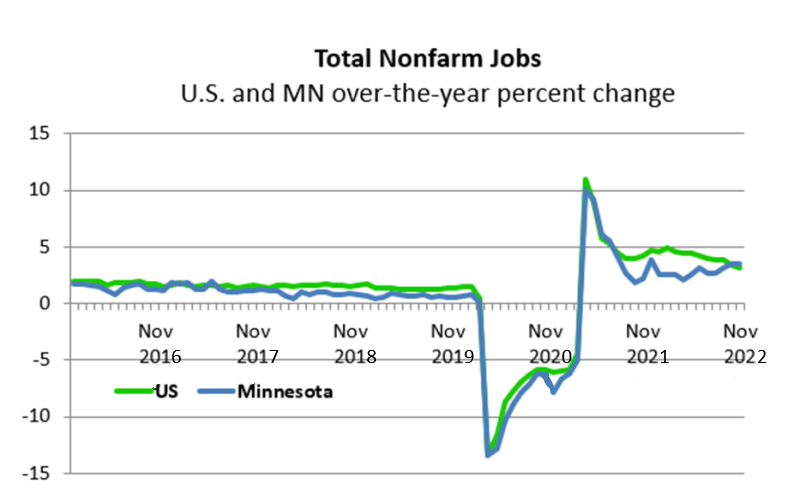by Nick Dobbins
December 2022
The Minneapolis-St. Paul-Bloomington MSA added 3,476 jobs (0.2%) over the month in November. Trade, Transportation, and Utilities added 6,700 jobs (1.9%) thanks in large part to the addition of 4,929 jobs (2.8%) in Retail Trade; Government employers added 5,061 jobs (2.1%) driven by the addition of 4,208 jobs (2.7%) at the Local Government level, primarily in non-educational, employment, which was up 3,699 or 5.2%. The growth in these supersectors countered losses in some highly seasonal industries, as Mining, Logging, and Construction shed 5,448 jobs (5.8%) and Leisure and Hospitality lost 3,885 jobs (2.2%).
Over the year the Twin Cities metro area added 78,620 jobs or 4%. This was the largest proportional over-the-year growth of any MSA primarily in Minnesota. Every supersector in the metro posted positive annual growth. Leisure and Hospitality was up 13,033 or 8.3%, the largest proportional growth of any supersector. Manufacturing was up 13,215 jobs (6.7%), Educational and Health Services was up 17,638 (5.2%), and Professional and Business Services was up 19,156 job or 5.9%, the largest real job growth of any supersector. The lion's share of that growth came in Administrative and Support and Waste Management, which was up 10,676 jobs or 10.1%.
The Duluth-Superior MSA lost 917 jobs or 0.7% in November. This was the lowest proportional growth of any MSA primarily in Minnesota. Mining, Logging, and Construction lost 758 jobs or 6.6%, which was the largest real and proportional decline of any supersector in the area. Leisure and Hospitality employers lost 451 jobs or 3.1%. Educational and Health Services employment was up 369, or 1.2%, which was the largest real and proportional growth in any supersector.
Over the year, the Duluth area added 3,141 jobs (2.4%). Mining, Logging, and Construction added 791 jobs (7.9%), Leisure and Hospitality added 647 jobs (4.8%), and Educational and Health Services added 776 jobs (2.5%). Overall, seven of 10 published supersectors added jobs on the year, with the declines coming in Government (down 115 or 0.5%), Financial Activities (down 123, 2.4%), and Information (down 35, 3.4%).
The Rochester MSA added 578 jobs or 0.5% over the month in November. This was the largest proportional growth of any MSA primarily in Minnesota. Trade, Transportation, and Utilities added 422 jobs (2.4%) with growth driven by the Retail Trade component sector, up 367 jobs or 3%. Educational and Health Services added 417 jobs (0.8%). The largest real and proportional decline came in the highly seasonal Mining, Logging, and Construction supersector, which shed 270 jobs or 4.6%.
Over the year the Rochester area added 4,135 jobs or 3.4%. Leisure and Hospitality employment was up 9.1% (955 jobs), the largest proportional growth of any supersector. The largest real job growth came in Educational and Health Services, which added 1,653 jobs or 3.1%. Overall, eight of 10 published supersectors posted positive growth in the area, with the only exceptions being Financial Activities (down 87 jobs or 3.1%) and Information (down 27 jobs or 2.2%).
Employment in the St. Cloud MSA was up 0.1% (76 jobs) in November. The largest real and proportional monthly growth came in Trade, Transportation, and Utilities, which added 340 jobs (1.5%). Component sector Retail Trade added 300 jobs (2.2%) as the holiday season approached. Alternately, Mining, Logging, and Construction lost 446 jobs (5%), the largest negative real and proportional growth, as cold weather moved in, and employment in largely warm weather industries declined.
Over the year the St. Cloud area added 2,517 jobs (2.3%). This was the lowest proportional over-the-year growth of any MSA primarily in Minnesota, although it was ahead of both MSAs we share with North Dakota. Mining, Logging, and Construction employment was up 786 or 10.2%, the largest real and proportional growth in the area. Educational and Health Services added 665 jobs (3.1%), and Trade, Transportation and Utilities added 686 jobs (3.1%). The largest declines came in Financial Activities (down 149 jobs or 2.8%) and Information (down 35 jobs or 2.4%).
The Mankato-North Mankato MSA lost 122 jobs (0.2%) in November. Service providers lost 157 jobs (0.3%) while goods producers added 35 jobs (0.3%). The private and public sector employers both posted negative growth.
Over the year the Mankato-North Mankato area added 1,501 jobs (2.7%). Goods producers added 741 jobs or 7.2%, and service providers added 760 jobs or 1.6%. Private sector employers added 1,634 jobs (3.5%) while public sector employers lost 133 jobs (1.3%).
The Fargo-Moorhead MSA lost 344 jobs (0.2%) over the month of November. Leisure and Hospitality lost 369 jobs (2.7%), which was the largest proportional decline of any supersector, and Mining, Logging, and Construction lost 230 jobs (2.4%). Trade, Transportation, and Utilities had the largest real and proportional growth, adding 288 jobs or 0.9%.
Over the year the Fargo-Moorhead MSA added 578 jobs or 0.4%. This was the lowest proportional growth of any MSA in the state. Growth in Professional and Business Services (up 543 or 3.6%), Other Services (up 227 or 4.7%), and Trade, Transportation, and Utilities (up 520 or 1.7%), among others, was partially curbed by the loss of 984 jobs (8.3%) in Financial Activities.
The Grand Forks-East Grand Forks MSA added 170 jobs (0.3%) in November. Trade, Transportation, and Utilities added 163 jobs (1.6%) with the addition of 104 jobs (1.7%) in Retail Trade and 67 jobs (3.1%) in Transportation, Warehousing and Utilities. Three supersectors lost jobs on the month, with the steepest decline coming in Mining, Logging, and Construction (down 193 or 5.9%).
Over the year the Grand Forks-East Grand Forks MSA added 356 jobs (0.7%). Educational and Health Services added 218 jobs (2.4%), and Professional and Business Services added 138 jobs (3.6%). Government employers lost 465 jobs (3.6%) with most of those losses coming at the Local level, which was down 454 jobs (7.3%).
